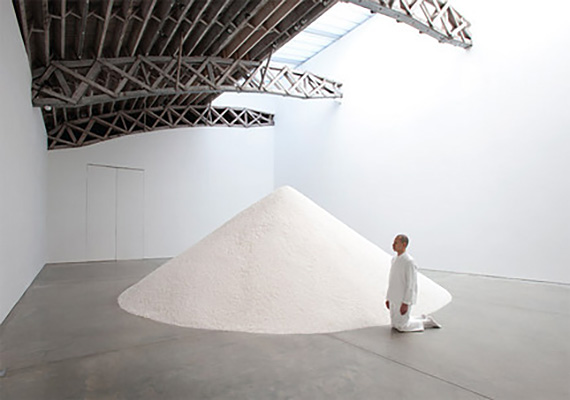
- Source: ARTFORUM
- Author: David Velasco
- Date: March 15, 2011
- Format: PRINT AND DIGITAL
Terence Koh: nothingtoodoo
Exhibition Review

Terence Koh, nothingtoodoo, 2011. Performance view, February 15, 2011.
For better or worse, Terence Koh is a serious artist. You have to be serious to spend twenty-six days in a gallery circumnavigating a mountain of salt on your knees, as Koh did for “nothingtoodoo,” his solo debut at Mary Boone Gallery. And you really have to be serious to take a vow of silence, as Koh also did, for the duration of the exhibition. The often hushed, almost reverential tone of the audience reflected and bolstered this seriousness, as did the artist’s overall aesthetic fussiness: his all-white outfit, the removal of any vestiges of decoration from the gallery’s reception space, the care with which the edges of the salt mound were realigned at the end of each day.
Koh must be serious. But it is also so often the way that the serious and the unserious dovetail in his work that gives it traction. “Maybe the work is an extended apology for past bad-boy behavior,” Roberta Smith proposes in her review for the New York Times, thus displacing the larger art-historical trajectory (Marina Abramović, Yoko Ono, Tehching Hsieh, Eiko & Koma) and situating “nothingtoodoo” in the lineage of celebrity rehab. And so the self-proclaimed “Naomi Campbell of the art world” enacts his own self-imposed community service—sans Steven Klein tabloid-style photo shoot, but still. In 2008, Campbell spent two hundred hours working off her transgressions at London’s Whitechapel Mission center; in 2011, Koh spent two hundred hours kneeling and prostrating around a cone of salt. “I have to tell you, I find solace in sweeping,” the model prisoner told W magazine in June 2007, after another, shorter community-service stint with the New York Sanitation Department. “I have no other responsibilities. I have no phone. I have time to think. I just have, you know, peace.”
“Peace iz nothingtoodoo,” Koh states in an opaque letter that accompanied the exhibition. This is not Ono’s wishful thinking—imagine peace—but a confirmation of the immediacy of presence: “[P]eace iz non-violence; peace iz everywhere; peace iz now,” Koh also writes in the missive. The fumbled, childlike spelling and lowercase scrawl in his statement seem senseless, boldly anti-serious, and contrasts sharply with his insistent, diurnal, tasklike performance. No other responsibilities. His words have a terse, generic charm, like humanist aphorisms drilled into grade-school students. But the work and its title also invoke the droll irony of Immanuel Kant, who speculated that one version of “perpetual peace” might be the “vast burial ground of the human race.” Koh’s abstruse, painful-looking, and frankly beautiful repetition could proffer an alternative to mass extinction, for application by the living. It doesn’t seem a viable option, but it is something. Nothing to do, indeed.
At the end of the performance’s final day, Koh stood up, gave a humble wave, and retired to the back room. Young men dressed in white emerged from the gallery’s offices with platters of salt pebbles and ice dipped in lemon. I stood sucking on the sweet ice, which lost its sweetness as I sucked, and wondered why “endurance” persists as a mode in performance art, and whether it’s possible—especially now, when the business of authenticity seems so entangled with the terms of the market—to engage with the practice without also rehearsing a nostalgia for another generation of performance artists, for a time when such things could be taken seriously. For a time when I might see a poignant endurance piece in a gallery and not recall episode eighty-six of Sex and the City, in which Mikhail Baryshnikov defends an ersatz version of Abramović’s The House with the Ocean View, 2002, to Sarah Jessica Parker. “I am serious; she is serious. You’re the one who is not serious,” he tells her, before asking her out on a date. I still don’t know how to take “nothingtoodoo” seriously, or, indeed, if a “serious” reception voids it of a certain productive resonance, of that high/low tension that Koh has so frequently worked with aplomb.

